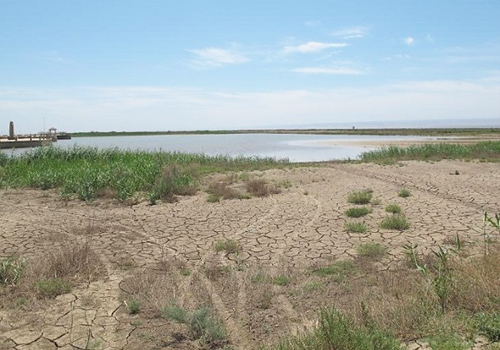lacustrine plain
ALSO CALLED A lake plain, a lacustrine plain is an area created out of deposition largely related to the past existence of lakes in the area, although in some cases, the original lakes still exist, having shrunk in size over time. Lacustrine refers to the condition of being affected by a lake or several lakes. Lacustrine plains are some of the flattest of all landform features and have few surface interruptions, although they may contain freshwater marshes, aquatic beds and lakeshore environments. Lacustrine plains are of varying origin, but most are underlain by fine, flat-bedded silt and clay deposited in lakes. The plains are typically related to the impoundment of water by one of the following processes: GLACIATION, differential uplift, and lake creation in now-arid inland basins.

Lacustrine plains that are glacial in origin are known as glaciolacustrine plains, and these are largely created from the trapping and ponding of water on the irregular land surface left by the former continental glaciers. In regions where there were thick masses of stagnating continental ice, steep-sided holes through the dead ice occasionally held lakes. Water was retained in these lakes by the ice walls. Fine-grained sediments (muds) accumulated on the lake bottoms. Once the ice walls melted away, however, the lakes drained, leaving the lake bottoms as plateau-like features underlain by fine-grained sediments. These lakes are largely ephemeral or temporal, eventually draining after the ice is gone. The present Great Lakes region in North America is bordered in many places by extensive lacustrine plains showing the former extent of the lakes. The Lake Agassiz plain is the biggest of these, reflecting the size of the former lake which was bigger than all the present Great Lakes put together.
The lack of topography of glaciolacustrine plains is due to the infilling of deep parts of the lake with clays and silt and wave erosion on the shallower parts of the lake. In North America and some other parts of the world, glaciolacustrine plains are of greatest interest because they often provide suitable land for intensive agriculture, and their flat topography permits mechanized farming. Lake ERIE and Saginaw Bay on Lake HURON were once much higher and extended inland, and the bottom of those bodies of water now makes up the lacustrine plains near Saginaw and Monroe. Large cities such as Chicago, Cleveland, Detroit, and Toledo also originated on the flat plains, where the dry beach ridges of the former lake edges served as roads. The flat lacustrine plains continue to absorb the urban expansion of these cities today. One handicap is that such areas are also poorly drained. Chicago lies on a plain formed when Lake MICHIGAN stood higher, and the city is often beset by the flooding of sewers, basements, and underpasses.
Other lake plains not associated with glaciers include the Congo Lake Plain and the lake plain of south SUDAN in Africa. These broad, flat plains of fine sediment were formed originally as enormous, in-filled basins created through differential uplift during the middle and late Pleistocene. The lakes were drained when the NILE and CONGO rivers eventually eroded their valleys, exposing large expanses of the former lake floors.
Lacustrine plains are also found in inland sites of present arid areas. The lakes associated with these plains were formed in a time of increased rainfall and reduced evaporation. The Chad Basin Plain in Africa, the Lake Eyre Plain in central AUSTRALIA, the plains around the CASPIAN SEA and the plains formed by Lake Bonneville in western UTAH are notable examples.
The size of lacustrine plains varies according to the size of the original lake. The Superior Lake Plain, covering parts of the U.S. states of MICHIGAN, MINNESOTA, and WISCONSIN, is roughly 1,910 square mi (4,950 square km) in size. The Chad Basin Plain extends to about 919,554 square mi (2,381,635 square km) in size and is shared by seven countries: NIGERIA, NIGER, ALGERIA, Sudan, CENTRAL AFRICA REPUBLIC, CHAD, and CAMEROON.